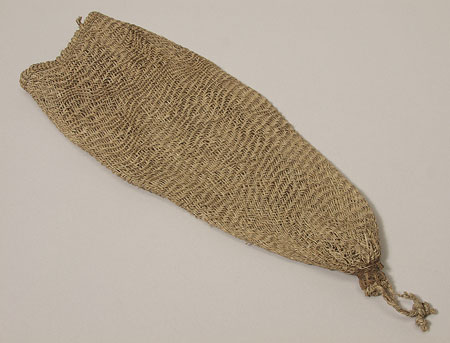Accession Number:
1936.10.48
Country:
Sudan
Region:
[Southern Sudan]
Cultural Group:
Anywaa [Anuak]
Date Made:
By 1936
Materials:
Plant Fibre
Process:
Basketry , Woven , Plaited , Tied , Twill
Dimensions:
Max L = 332 mm Max W [mouth] = 90 mm Max W [upper body] = 122 mm Max W [base] = 14.5 mm Max W [strand] = 1 mm
Weight:
26.4 g
Local Name:
adhinga
Other Owners:
Presumably collected by Evans-Pritchard during his period of fieldwork amongst the Anuak between early March and May 1935 [RTS 18/6/2004].
Field Collector:
Edward Evan Evans-Pritchard
PRM Source:
Edward Evan Evans-Pritchard
Acquired:
Donated 1936
Collected Date:
March - May 1935
Description:
Small tightly woven basketry beer strainer, consisting of a fairly narrow mouth whose rim has been formed by taking the ends of 64 narrow plant fibre strips, and bending each over at the top to form a loop; the loose ends hang down the inside of the mouth, where they are secured by similar strips woven in and out of the body in two horizontal rows.
A third row runs beneath these, and is visible on the outside face; on the inside, this runs beneath the loose hanging ends.
The ends of the horizontal strips have been knotted, then the separate strands plaited together and knotted a second time at the top, leaving a short plaited length projecting up from the rim.
Below this horizontal band, the vertical strips continue to form the body of the strainer, tightly woven in a bias (e.g.: diagonal) twill, with each strand passing over two and then under two strands at right angles to it.
The body expands slightly below the rim, and then tapers towards its base, with all the fibre strips gathered together at the bottom and secured with a reddish brown twisted plant fibre cord wrapped around the body a number of times (Pantone 477C).
There is also a further strip that is wrapped vertically around the lower part of this, and used to secure a separate loop made of a piece of plaited plant fibre, with the loose ends tied together at the base.
This has broken on one side.
The strainer has been pressed flat and thus has a crease running down either side of the body.
The mouth expands to make a diamond shape when opened.
Essentially complete, there are numerous small breaks in the weave making up the body.
The bag is a pale yellowish brown colour (Pantone 7508C), and is 332 mm long, 90 mm wide across the mouth, 122 mm wide across the upper body, and 14.5 by 13 mm wide at its base, with a weight of 26.4 grams.
Each individual fibre strand making up the body weave has a width of 1 mm.
Collected by Edward Evan Evans-Pritchard during his fieldwork amongst the Anuak, between early March and May 1935 (E.E. Evans-Pritchard, 1940, The Political System of the Anuak of the Anglo-Egyptian Sudan, p. 3).
This object is known as adhinga. Similar types of woven bag are used by numerous other groups to strain beer, including the Acholi, the Lango and the Kakwa (M. Trowell & K.P. Wachsmann, 1953, Tribal Crafts of Uganda, pp 165-6, pl. 39o); see also 1979.20.83, from the Dinka Tuich.
Rachael Sparks 20/9/2005.
Collected by Edward Evan Evans-Pritchard during his fieldwork amongst the Anuak, between early March and May 1935 (E.E. Evans-Pritchard, 1940, The Political System of the Anuak of the Anglo-Egyptian Sudan, p. 3).
This object is known as adhinga. Similar types of woven bag are used by numerous other groups to strain beer, including the Acholi, the Lango and the Kakwa (M. Trowell & K.P. Wachsmann, 1953, Tribal Crafts of Uganda, pp 165-6, pl. 39o); see also 1979.20.83, from the Dinka Tuich.
Rachael Sparks 20/9/2005.
Primary Documentation:
Accession Book Entry [p.
410] - 1936 [insert] 10 [end insert] E.
EVANS-PRITCHARD, M.A., Exeter College, Oxford.
- Specimens collected by himself in the EASTERN SUDAN, while travelling with a Grant from the Rockefeller Leverhulme Trustees, viz: [p.
414] [insert] 48 [end insert] - Adhinga, basketry strainer for beer, ANUAK.
Card Catalogue Entry - There is no further information on the catalogue card [RTS 30/1/2004].
Old Pitt Rivers Museum label - Adhinga, filter for beer. ANUAK, E. SUDAN. d.d. E. Evans-Pritchard 1936. [rectangular metal-edged tag, tied to object; RTS 7/7/2004].
Card Catalogue Entry - There is no further information on the catalogue card [RTS 30/1/2004].
Old Pitt Rivers Museum label - Adhinga, filter for beer. ANUAK, E. SUDAN. d.d. E. Evans-Pritchard 1936. [rectangular metal-edged tag, tied to object; RTS 7/7/2004].




